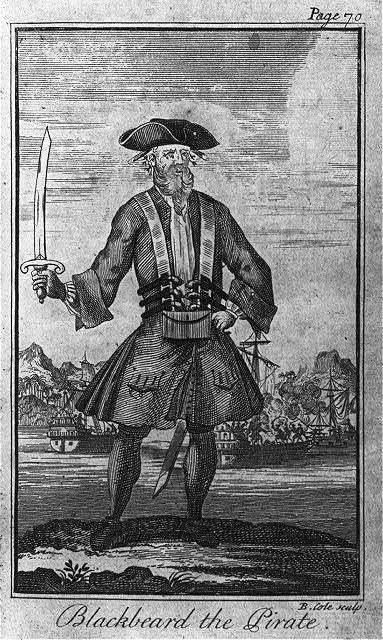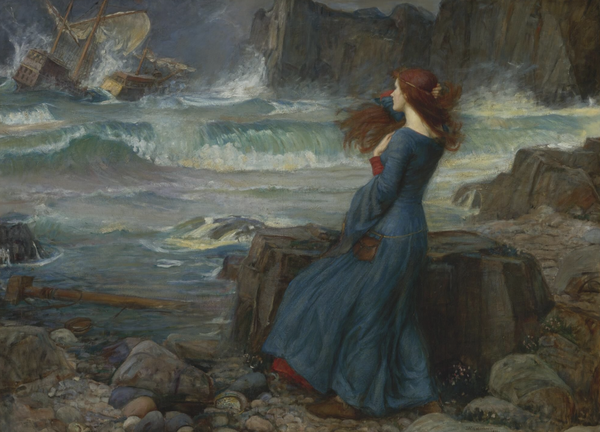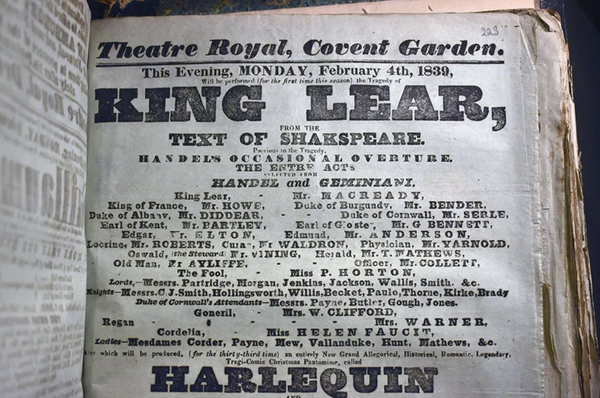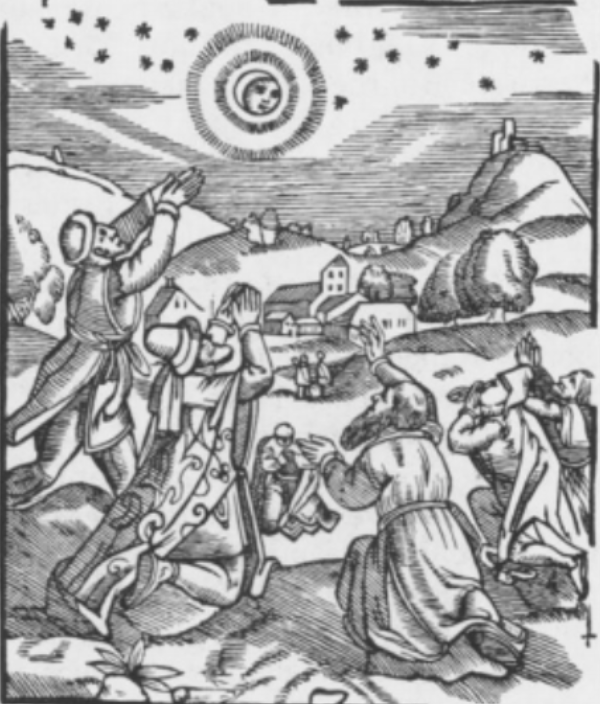Volume 17: February 1, 2021
Contextualizing Hamlet's Pirates
By London Johns
Possibly the strangest part of Shakespeare’s Hamlet is a passage in which Hamlet claims that he has been captured by pirates on the way to England. The pirates are only written about in a letter, and they never appear onstage. Nevertheless, they play an essential role in the plot of the play: capturing Hamlet on the ship on which he was traveling to England and bringing him back to Denmark. The presence of pirates in Hamlet has long been considered a bizarre deus ex machina -- they seem to appear from nowhere and exist to speed the plot towards its conclusion. While the purpose of the pirates is to explain Hamlet’s journey back to Denmark, they also reflect a broader trend in Elizabethan literature and politics that glorified piracy as it became a necessary political tool.
The pirates appear only briefly in Act 4 of Hamlet, in a letter that Hamlet writes to Horatio after departing for England. According to Hamlet’s letter, while Hamlet, Rosencrantz, and Guildenstern were travelling to England, a
“pirate of very warlike appointment gave us chase. Finding ourselves too slow of sail, we put on a compelled valor, and in the grapple I boarded them. On the instant, they got clear of our ship; so I alone became their prisoner. They have dealt with me like thieves of mercy, but they knew what they did: I am to do a good turn for them.” (Shakespeare, Hamlet 4.6.16-22)
The pirates are never again mentioned. Because of their intervention, Hamlet is able to return to Denmark while Rosencrantz and Guildenstern continue on to England and their deaths. Notably, in the text that inspired Elizabethan interpretations of Hamlet -- Saxo Grammaticus’s Gesta Danorum -- no pirates ever arrived to bring Hamlet home. Amleth, the character who would become Hamlet, went on a similar journey to England. However, unlike Hamlet, he arrived safely at his destination, oversaw his companions’ execution, and negotiated himself into a marriage with the daughter of the King of England (Saxo Grammaticus). The Ur-Hamlet, another version of Hamlet that inspired Shakespeare’s play, could have included pirates. However, it is impossible to know; no copy of the play survives, and the only thing certain about it is that it contained a ghost (Lodge 56). The First Quarto version of Hamlet does not include pirates at all; instead, the ship was “crossed by the contention of the winds” (qtd. in Rutter 120). This suggests that the pirates were an invention by Shakespeare instead of being lifted from an earlier source. If none of the works from which Shakespeare drew inspiration for Hamlet contained the pirates that interrupted Hamlet’s journey in Shakespeare’s play, he must have had another reason to use piracy to halt Hamlet’s journey before he arrived in England.
By the time Shakespeare wrote Hamlet, piracy had been made into a tool in the conflict between England and Spain. In the 1580s, Queen Elizabeth I authorized privateers to attack Spanish ships and bring back treasure to the English government. Privateers were essentially legal pirates -- pirates with a mandate from the government to raid ships of a hostile nation (Fuchs 46). Privateers could keep a certain percentage of the money that they gained from raiding ships, but the rest was given to the Crown. Privateering served several purposes; it was cheaper than funding a navy capable of waging war with Spain, it gathered wealth, and it transformed already-existing pirates who had formerly been the government’s problem into a weapon at its disposal. Privateers were often seen as patriotic heroes and admired for their adventurous lifestyles. Shakespeare’s “Sonnet 25” uses a privateer as a metaphor for another poet’s skills, and its target as the speaker’s lover: “Was it the proud full sail of his great verse,/Bound for the prize of all-too-precious you,/That did my ripe thoughts in my brain inhearse,/Making their tomb the womb wherein they grew?” (Shakespeare, The Sonnets 89)
Though sometimes written about in sympathetic terms, illegal piracy was not granted the same praise as privateering. However, the line between legal and illegal piracy was blurred. In 1580, an explorer named Francis Drake received knighthood. Queen Elizabeth had taken note of his involvement in unlawful slave trading in the Spanish colonies, and in 1577 she chose him to lead an expedition to “find out places meet to have traffic” on the west coast of South America (qtd. in Fernández-Armesto and Bradford). Throughout the journey, Drake raided Spanish ships and stole their treasure; he returned to England bearing “bars of gold and silver, minted Spanish coinage, precious stones, and pearls” (Fernández-Armesto and Bradford). His piracy was criticized by the Spanish government, but Queen Elizabeth nevertheless knighted him for his expedition, and he was soon named the mayor of Plymouth (Fernández-Armesto and Bradford). Piracy was rewarded, and even regarded as heroic, as long as it was profitable.
As well as acting as political pawns, pirates could be found relatively frequently in Elizabethan and Jacobean drama. According to Jacques Lezra, pirates were “established agents of unexpected intrusion,” a tradition adopted from Greek romances (qtd. in Potter 124). Pirates, who operated outside the law, were able to act outside of the system to which other characters had to conform. They had a power, Lois Potter noted, like that of Robin Hood: they could defend “a kind of justice that cannot be found in supposedly civilized society” (Potter 124). Because of their lack of allegiance to a government, the pirates in Hamlet have no reason not to help Hamlet in return for a “good turn.” It would not matter to them that Claudius wanted him dead. Shakespeare used pirates either to carry out a form of lawless justice or as a deus ex machina in several plays; once in Henry VI, when a pirate attacks the Duke of Suffolk (qtd. in Potter 125), and again in Pericles, Prince of Tyre, when Marina is kidnapped by pirates and sold to a brothel. In doing this, the pirates save Marina from being murdered by her jealous guardians, Cleon and Dionyza. Similarly, the pirates in Hamlet save Hamlet from murder by the King of England. Both the pirates in Pericles and Hamlet act as a bridge between one part of the plot and another and literal transportation for the character from one place to another.
Though the versions of Hamlet’s story that preceded Shakespeare’s Hamlet make no mention of his encounter with pirates, encounters with pirates did occur in other historical stories from which Shakespeare drew inspiration for his plays. In Plutarch’s Lives of the Noble Grecians and Romanes, which Shakespeare used to aid in the writing of Julius Caesar in 1599 , Plutarch wrote that Caesar
“was taken by pyrates about the Ile of Pharmacusa: for those pyrates kept all uppon that sea coast, with a great fleete of shipped and botes. They asking him at the first twentie talentes for his ransome, Caesar laughed them to scorne, as though they knew not what a man they had taken, and of him selfe promised them fiftie talents. Then he sent his men up and downe to get him this money. . . . Thus was he eight and thirtie dayes among them, not kept as prisoner, but rather waited uppon by them as a Prince.” (qtd. in Wentersdorf 436)
This incident may have been on Shakespeare’s mind as he wrote Hamlet; Julius Caesar was written at around the same time as the final version of Hamlet. Perhaps Shakespeare intended to prove Hamlet’s nobility by revealing that he, like Caesar, was able to sway pirates intent upon murdering him, thereby transforming “warlike” men into “thieves of mercy” (Shakespeare, Hamlet 4.6.16-22). Alternatively, the similarities between the pirates met by Caesar and Hamlet could have been signs that the end of the tragedy was approaching. If Hamlet’s encounter with the pirates was meant to call to mind Caesar’s own time held captive on a pirate ship, it would build upon a troubling connection that Horatio made in Act I Scene I upon seeing the ghost of Hamlet’s father: “A little ere the mightiest Julius fell,/The graves stood tenantless, and the sheeted dead/Did squeak and gibber in the Roman streets” (Shakespeare, Hamlet 1.1.126-128). Horatio remarked that ghosts had predicted misfortune before Caesar’s assassination, and that the appearance of King Hamlet’s ghost must also be an omen of trouble on the horizon. By once again connecting Hamlet’s fate to Caesar’s, Hamlet’s tale of being captured by pirates likely reminded Shakespeare’s audience about Horatio’s prediction of doom.
To a modern audience, Hamlet’s brief account of being captured by pirates may seem bizarre, unrealistic, or even comical. To an Elizabethan audience, however, stories of pirates -- both real and fictional -- would have been familiar. What may have seemed stranger to them was that the pirates’ treatment of Hamlet was a consequence of their lawlessness in a time when many pirates had become instruments of the law.
Works Cited
Cole, B. “Blackbeard the Pirate.” 1725. Library of Congress, Library of Congress, www.loc.gov/pictures/item/2007677050/.
Fernández-Armesto, Felipe, and Ernle Bradford. “Mayor of Plymouth.” Encyclopædia Britannica, Encyclopædia Britannica, Inc., 24 Jan. 2021, www.britannica.com/biography/Francis-Drake/Mayor-of-Plymouth.
Fuchs, Barbara. “Faithless Empires: Pirates, Renegadoes, and the English Nation.” ELH, vol. 67, no. 1, 2000, pp. 45–69. JSTOR, www.jstor.org/stable/30031906. Accessed 2 Feb. 2021.
Lodge, Thomas. Wits Miserie and the Worlds Madnesse: Discovering the Devils Incarnat of This Age. B.L. 1596. Print.
Potter, Lois. “Pirates and 'Turning Turk' in Renaissance Drama.” Travel and Drama in Shakespeare's Time, edited by Jean-Pierre Maquerlot and Michèle Willems, Cambridge University Press, 2006, pp. 124–140.
“Queen Elizabeth Knighting Sir Francis Drake.” The British Museum, The British Museum, 1895, www.britishmuseum.org/collection/object/P_1895-0617-865.
Rutter, Tom. “‘Hamlet’, Pirates, and Purgatory.” Renaissance and Reformation / Renaissance Et Réforme, vol. 38, no. 1, 2015, pp. 117–139., www.jstor.org/stable/43918752. Accessed 2 Feb. 2021.
Shakespeare, William. Hamlet. Edited by Barbara Mowat and Paul Werstine, Folger Shakespeare Library, The Folger Shakespeare, shakespeare.folger.edu/.
Shakespeare, William. The Sonnets. Edited by A. R. Braunmuller and Stephen Orgel, Penguin, 2017, Google Books, books.google.com/books?id=gqKDDgAAQBAJ.
Wentersdorf, Karl P. “Hamlet's Encounter With the Pirates.” Shakespeare Quarterly, vol. 34, no. 4, 1983, pp. 434–440. JSTOR, www.jstor.org/stable/2869861. Accessed 2 Feb. 2021.
Grammaticus, Saxo. The Danish History, Books I-IX. Translated by Oliver Elton, edited by Douglas B. Killings and David Widger, Project Gutenberg , 2006, Project Gutenberg, www.gutenberg.org/files/1150/1150-h/1150-h.htm.







